A Comparative Analysis of Negotiation Approaches in Organizations
VerifiedAdded on 2023/06/11
|10
|2789
|470
Report
AI Summary
This report provides a comparative analysis of positional (competitive) and interest-based (collaborative) negotiation approaches, highlighting their characteristics, assumptions, risks, and impact on relationships within an organization. The competitive positional approach is characterized by a win-lose dynamic, manipulation, and a focus on maximizing individual interests, while the interest-based approach aims for a win-win outcome through collaboration, information sharing, and mutual problem-solving. The report discusses the assumptions underlying each approach, such as the competitive approach assuming a zero-sum game and the interest-based approach prioritizing mutual gain and long-term relationships. Risks associated with each approach are also examined, including damaged relationships and potential legal issues in the competitive approach, and difficulties in implementation and perceived inequality in the interest-based approach. Recommendations are made for Barbara to adopt an interest-based approach, emphasizing effective communication, training for employees, and leading by example to foster a healthy team culture and long-term stakeholder relationships. The report concludes that understanding and strategically applying these negotiation approaches is crucial for effective leadership and conflict resolution in organizations.

ETHICS
Paraphrase This Document
Need a fresh take? Get an instant paraphrase of this document with our AI Paraphraser
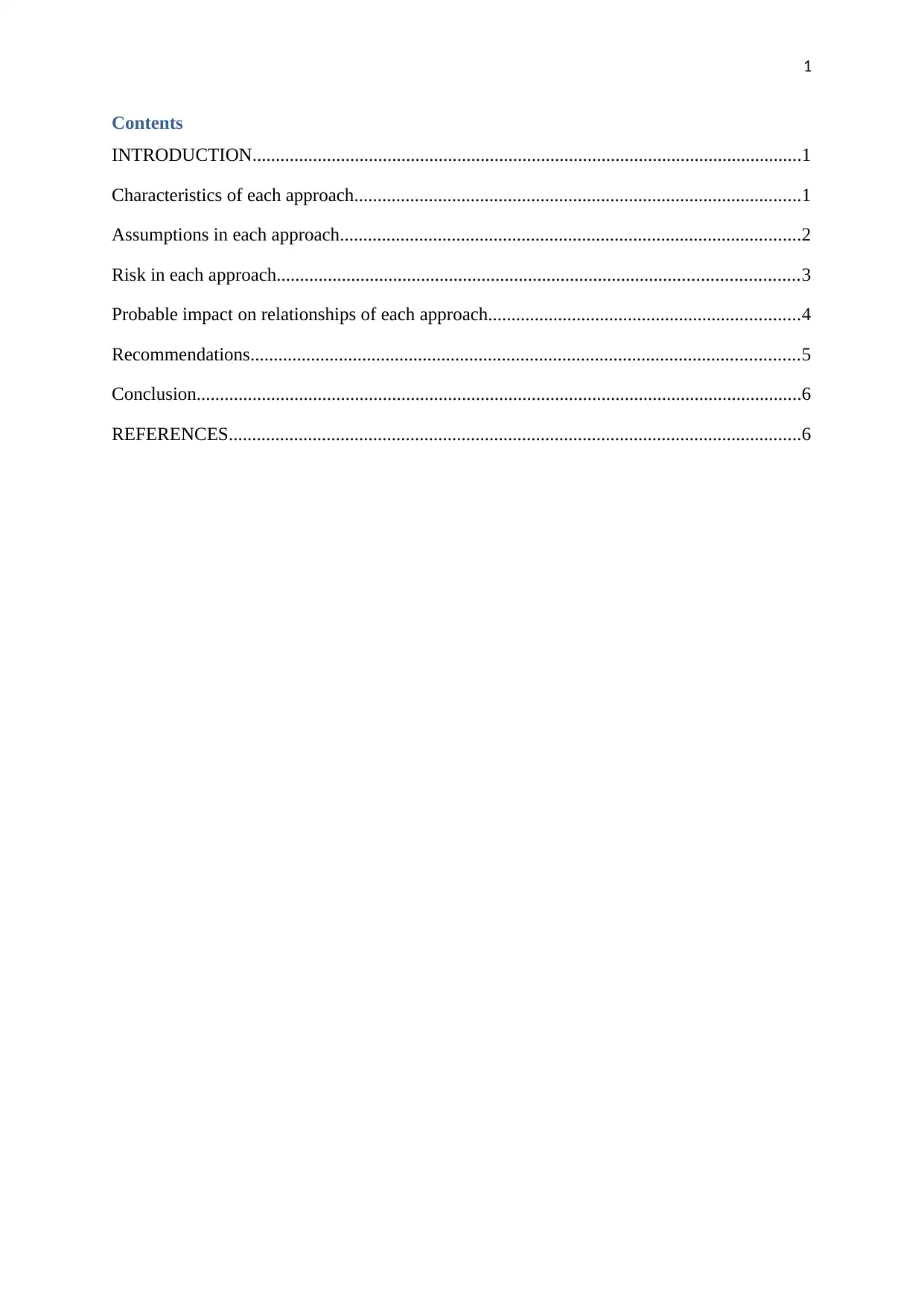
1
Contents
INTRODUCTION......................................................................................................................1
Characteristics of each approach................................................................................................1
Assumptions in each approach...................................................................................................2
Risk in each approach................................................................................................................3
Probable impact on relationships of each approach...................................................................4
Recommendations......................................................................................................................5
Conclusion..................................................................................................................................6
REFERENCES...........................................................................................................................6
Contents
INTRODUCTION......................................................................................................................1
Characteristics of each approach................................................................................................1
Assumptions in each approach...................................................................................................2
Risk in each approach................................................................................................................3
Probable impact on relationships of each approach...................................................................4
Recommendations......................................................................................................................5
Conclusion..................................................................................................................................6
REFERENCES...........................................................................................................................6

2
INTRODUCTION
The purpose of this report is to provide brief information about the approaches of negotiation
and their significance in an organization. The report determines a case analysis under which
the training procedure explains that there is lack of competency in the employees. Resulting
to which, the report explains the best approach in training in negotiation that can be adopted
by Barbara. The report explains comparison between positional based negotiation and interest
based negotiation. It explains the characteristics of different approaches, its assumptions,
risks in both the approaches, probable impact of both the approaches. Lastly recommendation
to choose the best suited approach among both of them; further the competitive positional
approach explains that the manager should hold on to a fixed position or idea of what they
want and stick to it only, regardless of any other underlying interest. Whereas interest based
approach refers to the approach under which all the parties collaborate together to build a
win-win situation for both of them. Further, more details about the report are discussed
below:
Characteristics of each approach
The competitive positional based negotiation is also called win-lose, zero sum or claiming
value approach. This type of approach is based on the premises that one person can win only
at the cost of other person (Kuo, et. al., 2012). One needs to sacrifice or lose their position in
order to make the other person win. Further, the characteristics of this approach of
negotiation are discussed below:
One party wins in this case while the other party loses.
No resources of the organization can be divided so that the more one gets, the less the
other. Resources of the company cannot be divided unequally.
Each person’s interest conflicts in this case.
The dominant concern in this type of negotiation is done to maximize one’s own
interest.
The strategies under this type of negotiation include manipulation, withholding
information, forcing, teasing etc.
INTRODUCTION
The purpose of this report is to provide brief information about the approaches of negotiation
and their significance in an organization. The report determines a case analysis under which
the training procedure explains that there is lack of competency in the employees. Resulting
to which, the report explains the best approach in training in negotiation that can be adopted
by Barbara. The report explains comparison between positional based negotiation and interest
based negotiation. It explains the characteristics of different approaches, its assumptions,
risks in both the approaches, probable impact of both the approaches. Lastly recommendation
to choose the best suited approach among both of them; further the competitive positional
approach explains that the manager should hold on to a fixed position or idea of what they
want and stick to it only, regardless of any other underlying interest. Whereas interest based
approach refers to the approach under which all the parties collaborate together to build a
win-win situation for both of them. Further, more details about the report are discussed
below:
Characteristics of each approach
The competitive positional based negotiation is also called win-lose, zero sum or claiming
value approach. This type of approach is based on the premises that one person can win only
at the cost of other person (Kuo, et. al., 2012). One needs to sacrifice or lose their position in
order to make the other person win. Further, the characteristics of this approach of
negotiation are discussed below:
One party wins in this case while the other party loses.
No resources of the organization can be divided so that the more one gets, the less the
other. Resources of the company cannot be divided unequally.
Each person’s interest conflicts in this case.
The dominant concern in this type of negotiation is done to maximize one’s own
interest.
The strategies under this type of negotiation include manipulation, withholding
information, forcing, teasing etc.
⊘ This is a preview!⊘
Do you want full access?
Subscribe today to unlock all pages.

Trusted by 1+ million students worldwide
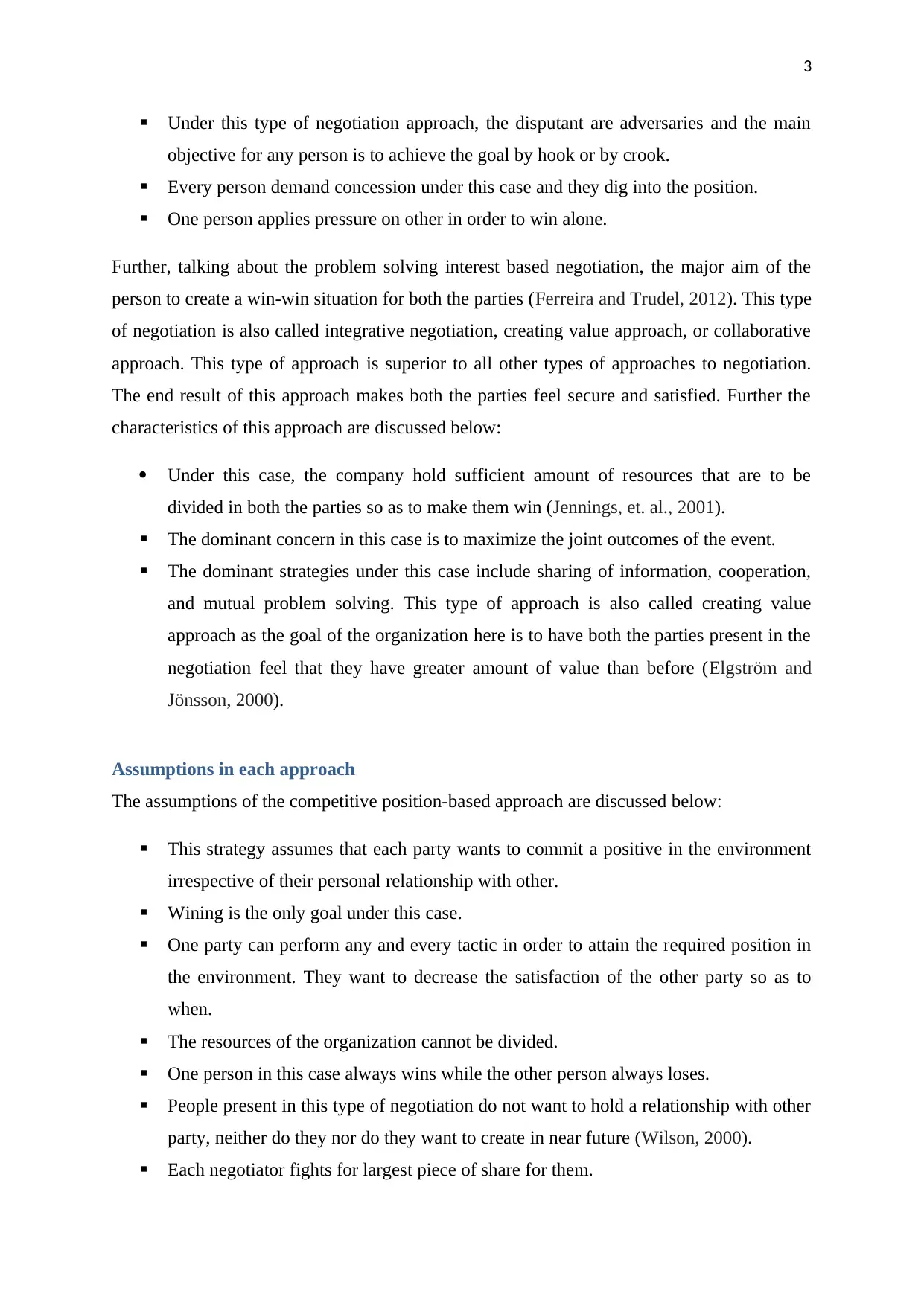
3
Under this type of negotiation approach, the disputant are adversaries and the main
objective for any person is to achieve the goal by hook or by crook.
Every person demand concession under this case and they dig into the position.
One person applies pressure on other in order to win alone.
Further, talking about the problem solving interest based negotiation, the major aim of the
person to create a win-win situation for both the parties (Ferreira and Trudel, 2012). This type
of negotiation is also called integrative negotiation, creating value approach, or collaborative
approach. This type of approach is superior to all other types of approaches to negotiation.
The end result of this approach makes both the parties feel secure and satisfied. Further the
characteristics of this approach are discussed below:
Under this case, the company hold sufficient amount of resources that are to be
divided in both the parties so as to make them win (Jennings, et. al., 2001).
The dominant concern in this case is to maximize the joint outcomes of the event.
The dominant strategies under this case include sharing of information, cooperation,
and mutual problem solving. This type of approach is also called creating value
approach as the goal of the organization here is to have both the parties present in the
negotiation feel that they have greater amount of value than before (Elgström and
Jönsson, 2000).
Assumptions in each approach
The assumptions of the competitive position-based approach are discussed below:
This strategy assumes that each party wants to commit a positive in the environment
irrespective of their personal relationship with other.
Wining is the only goal under this case.
One party can perform any and every tactic in order to attain the required position in
the environment. They want to decrease the satisfaction of the other party so as to
when.
The resources of the organization cannot be divided.
One person in this case always wins while the other person always loses.
People present in this type of negotiation do not want to hold a relationship with other
party, neither do they nor do they want to create in near future (Wilson, 2000).
Each negotiator fights for largest piece of share for them.
Under this type of negotiation approach, the disputant are adversaries and the main
objective for any person is to achieve the goal by hook or by crook.
Every person demand concession under this case and they dig into the position.
One person applies pressure on other in order to win alone.
Further, talking about the problem solving interest based negotiation, the major aim of the
person to create a win-win situation for both the parties (Ferreira and Trudel, 2012). This type
of negotiation is also called integrative negotiation, creating value approach, or collaborative
approach. This type of approach is superior to all other types of approaches to negotiation.
The end result of this approach makes both the parties feel secure and satisfied. Further the
characteristics of this approach are discussed below:
Under this case, the company hold sufficient amount of resources that are to be
divided in both the parties so as to make them win (Jennings, et. al., 2001).
The dominant concern in this case is to maximize the joint outcomes of the event.
The dominant strategies under this case include sharing of information, cooperation,
and mutual problem solving. This type of approach is also called creating value
approach as the goal of the organization here is to have both the parties present in the
negotiation feel that they have greater amount of value than before (Elgström and
Jönsson, 2000).
Assumptions in each approach
The assumptions of the competitive position-based approach are discussed below:
This strategy assumes that each party wants to commit a positive in the environment
irrespective of their personal relationship with other.
Wining is the only goal under this case.
One party can perform any and every tactic in order to attain the required position in
the environment. They want to decrease the satisfaction of the other party so as to
when.
The resources of the organization cannot be divided.
One person in this case always wins while the other person always loses.
People present in this type of negotiation do not want to hold a relationship with other
party, neither do they nor do they want to create in near future (Wilson, 2000).
Each negotiator fights for largest piece of share for them.
Paraphrase This Document
Need a fresh take? Get an instant paraphrase of this document with our AI Paraphraser
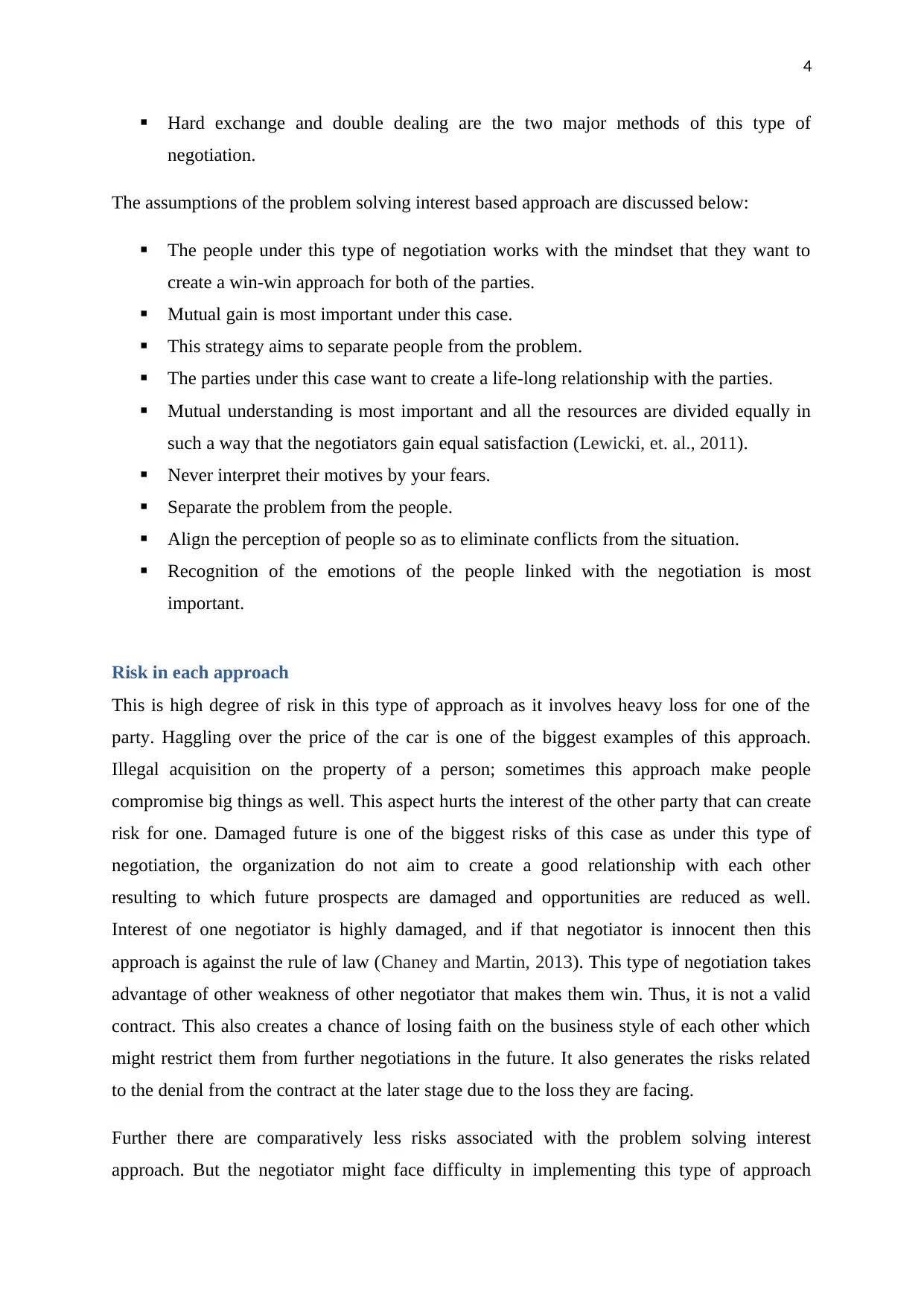
4
Hard exchange and double dealing are the two major methods of this type of
negotiation.
The assumptions of the problem solving interest based approach are discussed below:
The people under this type of negotiation works with the mindset that they want to
create a win-win approach for both of the parties.
Mutual gain is most important under this case.
This strategy aims to separate people from the problem.
The parties under this case want to create a life-long relationship with the parties.
Mutual understanding is most important and all the resources are divided equally in
such a way that the negotiators gain equal satisfaction (Lewicki, et. al., 2011).
Never interpret their motives by your fears.
Separate the problem from the people.
Align the perception of people so as to eliminate conflicts from the situation.
Recognition of the emotions of the people linked with the negotiation is most
important.
Risk in each approach
This is high degree of risk in this type of approach as it involves heavy loss for one of the
party. Haggling over the price of the car is one of the biggest examples of this approach.
Illegal acquisition on the property of a person; sometimes this approach make people
compromise big things as well. This aspect hurts the interest of the other party that can create
risk for one. Damaged future is one of the biggest risks of this case as under this type of
negotiation, the organization do not aim to create a good relationship with each other
resulting to which future prospects are damaged and opportunities are reduced as well.
Interest of one negotiator is highly damaged, and if that negotiator is innocent then this
approach is against the rule of law (Chaney and Martin, 2013). This type of negotiation takes
advantage of other weakness of other negotiator that makes them win. Thus, it is not a valid
contract. This also creates a chance of losing faith on the business style of each other which
might restrict them from further negotiations in the future. It also generates the risks related
to the denial from the contract at the later stage due to the loss they are facing.
Further there are comparatively less risks associated with the problem solving interest
approach. But the negotiator might face difficulty in implementing this type of approach
Hard exchange and double dealing are the two major methods of this type of
negotiation.
The assumptions of the problem solving interest based approach are discussed below:
The people under this type of negotiation works with the mindset that they want to
create a win-win approach for both of the parties.
Mutual gain is most important under this case.
This strategy aims to separate people from the problem.
The parties under this case want to create a life-long relationship with the parties.
Mutual understanding is most important and all the resources are divided equally in
such a way that the negotiators gain equal satisfaction (Lewicki, et. al., 2011).
Never interpret their motives by your fears.
Separate the problem from the people.
Align the perception of people so as to eliminate conflicts from the situation.
Recognition of the emotions of the people linked with the negotiation is most
important.
Risk in each approach
This is high degree of risk in this type of approach as it involves heavy loss for one of the
party. Haggling over the price of the car is one of the biggest examples of this approach.
Illegal acquisition on the property of a person; sometimes this approach make people
compromise big things as well. This aspect hurts the interest of the other party that can create
risk for one. Damaged future is one of the biggest risks of this case as under this type of
negotiation, the organization do not aim to create a good relationship with each other
resulting to which future prospects are damaged and opportunities are reduced as well.
Interest of one negotiator is highly damaged, and if that negotiator is innocent then this
approach is against the rule of law (Chaney and Martin, 2013). This type of negotiation takes
advantage of other weakness of other negotiator that makes them win. Thus, it is not a valid
contract. This also creates a chance of losing faith on the business style of each other which
might restrict them from further negotiations in the future. It also generates the risks related
to the denial from the contract at the later stage due to the loss they are facing.
Further there are comparatively less risks associated with the problem solving interest
approach. But the negotiator might face difficulty in implementing this type of approach
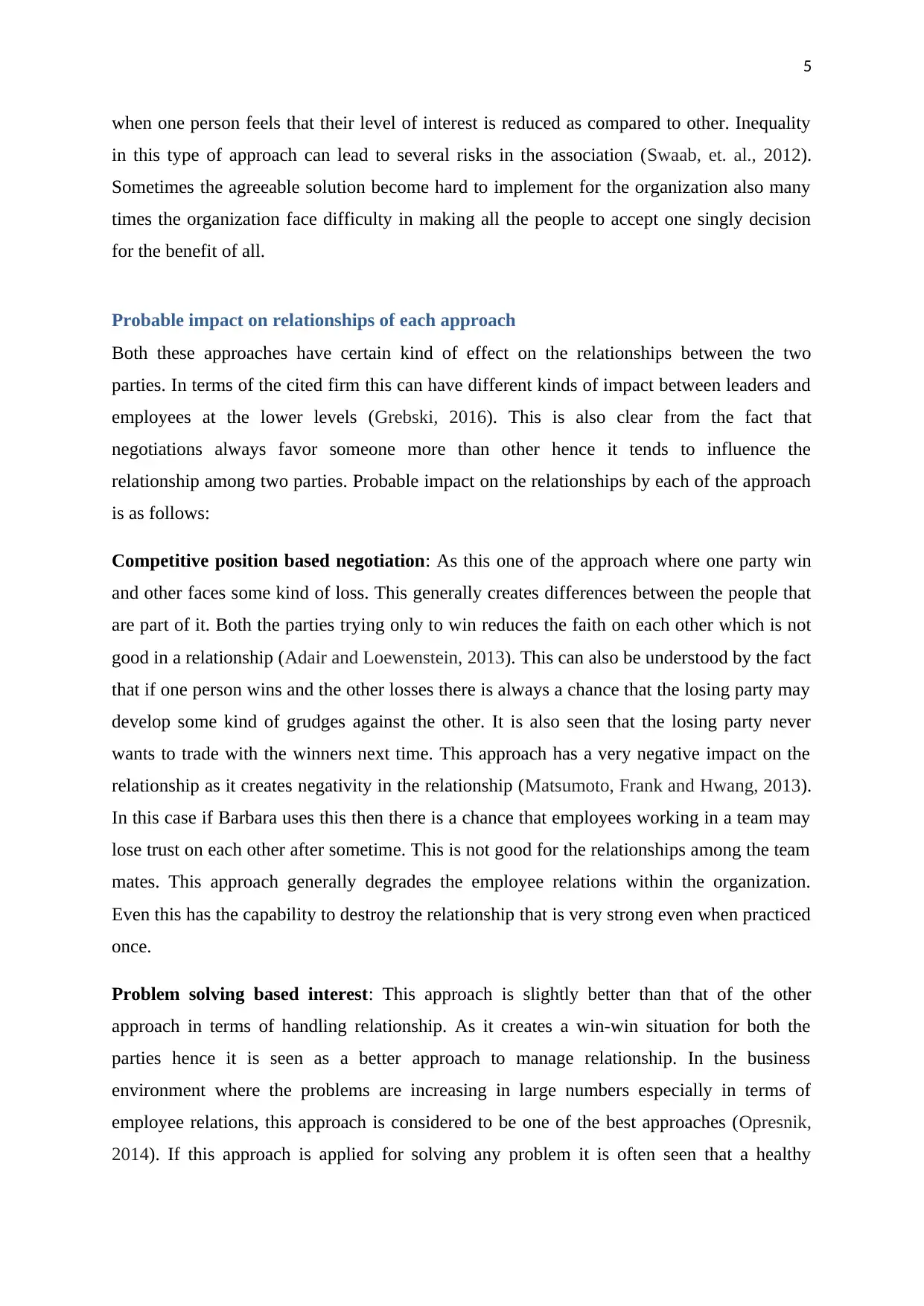
5
when one person feels that their level of interest is reduced as compared to other. Inequality
in this type of approach can lead to several risks in the association (Swaab, et. al., 2012).
Sometimes the agreeable solution become hard to implement for the organization also many
times the organization face difficulty in making all the people to accept one singly decision
for the benefit of all.
Probable impact on relationships of each approach
Both these approaches have certain kind of effect on the relationships between the two
parties. In terms of the cited firm this can have different kinds of impact between leaders and
employees at the lower levels (Grebski, 2016). This is also clear from the fact that
negotiations always favor someone more than other hence it tends to influence the
relationship among two parties. Probable impact on the relationships by each of the approach
is as follows:
Competitive position based negotiation: As this one of the approach where one party win
and other faces some kind of loss. This generally creates differences between the people that
are part of it. Both the parties trying only to win reduces the faith on each other which is not
good in a relationship (Adair and Loewenstein, 2013). This can also be understood by the fact
that if one person wins and the other losses there is always a chance that the losing party may
develop some kind of grudges against the other. It is also seen that the losing party never
wants to trade with the winners next time. This approach has a very negative impact on the
relationship as it creates negativity in the relationship (Matsumoto, Frank and Hwang, 2013).
In this case if Barbara uses this then there is a chance that employees working in a team may
lose trust on each other after sometime. This is not good for the relationships among the team
mates. This approach generally degrades the employee relations within the organization.
Even this has the capability to destroy the relationship that is very strong even when practiced
once.
Problem solving based interest: This approach is slightly better than that of the other
approach in terms of handling relationship. As it creates a win-win situation for both the
parties hence it is seen as a better approach to manage relationship. In the business
environment where the problems are increasing in large numbers especially in terms of
employee relations, this approach is considered to be one of the best approaches (Opresnik,
2014). If this approach is applied for solving any problem it is often seen that a healthy
when one person feels that their level of interest is reduced as compared to other. Inequality
in this type of approach can lead to several risks in the association (Swaab, et. al., 2012).
Sometimes the agreeable solution become hard to implement for the organization also many
times the organization face difficulty in making all the people to accept one singly decision
for the benefit of all.
Probable impact on relationships of each approach
Both these approaches have certain kind of effect on the relationships between the two
parties. In terms of the cited firm this can have different kinds of impact between leaders and
employees at the lower levels (Grebski, 2016). This is also clear from the fact that
negotiations always favor someone more than other hence it tends to influence the
relationship among two parties. Probable impact on the relationships by each of the approach
is as follows:
Competitive position based negotiation: As this one of the approach where one party win
and other faces some kind of loss. This generally creates differences between the people that
are part of it. Both the parties trying only to win reduces the faith on each other which is not
good in a relationship (Adair and Loewenstein, 2013). This can also be understood by the fact
that if one person wins and the other losses there is always a chance that the losing party may
develop some kind of grudges against the other. It is also seen that the losing party never
wants to trade with the winners next time. This approach has a very negative impact on the
relationship as it creates negativity in the relationship (Matsumoto, Frank and Hwang, 2013).
In this case if Barbara uses this then there is a chance that employees working in a team may
lose trust on each other after sometime. This is not good for the relationships among the team
mates. This approach generally degrades the employee relations within the organization.
Even this has the capability to destroy the relationship that is very strong even when practiced
once.
Problem solving based interest: This approach is slightly better than that of the other
approach in terms of handling relationship. As it creates a win-win situation for both the
parties hence it is seen as a better approach to manage relationship. In the business
environment where the problems are increasing in large numbers especially in terms of
employee relations, this approach is considered to be one of the best approaches (Opresnik,
2014). If this approach is applied for solving any problem it is often seen that a healthy
⊘ This is a preview!⊘
Do you want full access?
Subscribe today to unlock all pages.

Trusted by 1+ million students worldwide

6
business relationship gets created in the minds of the consumers. It is also good for the people
who want to have a business for the long term. In the case of Barbara since she is setting up
the business in a new way hence she needs to incorporate this in their business. This approach
is not only helpful in making the healthy relationships within the organization rather it is also
effective in creating employee satisfaction. Since both the parties comes to a common
concluding points hence nobody feels that he or she got cheated (Scollon, Scollon and Jones,
2011). This is also helpful in the case when there is huge conflict going on between the
management and employees. It is also helpful in resolving the situation when the relationship
has gone very weak like in the case of lockdown or strikes. In other words, it has a positive
impact on the relationships of the two parties as both gets satisfied with the deal and no one
faces any kind of loss.
Recommendations
After analyzing both the approach there are several things noticed on evaluating which for
Barbara certain recommendation needs to be made. First is the fact that for any negotiation
process, it is crucial to have an effective communication structure hence she needs to install
an effective communication mechanism. Second is that it must choose problem solving based
approach for any negotiation situation. This would benefit not only the two parties but a sense
of trust will also get generated between the different members of team (Hurley, 2012). This
will also help in creating long term relationship between the stakeholders of the firm. It is
recommended that a proper training must be given to the employees of the Barbara’s firm so
as to ensure that they able properly able to use problem solving based approach. The training
must be conducted for all the level of employees in the organization. Since the number of
problems are increasing day by day and maintaining the health team culture have become the
priority for the organization hence this can be very effective in this regards. It is also
recommended that Barbara herself sets the example of such kind of negotiation within the
firm. Along with this there must be regular monitoring of the approach so as to adopt this
approach in a best possible manner.
Conclusion
From the above based report, it can be concluded that there are different approaches to
negotiation. Out of which the two widely used approaches of negotiation are competitive
position-based approach and problem solving based approach. Both the approaches are
business relationship gets created in the minds of the consumers. It is also good for the people
who want to have a business for the long term. In the case of Barbara since she is setting up
the business in a new way hence she needs to incorporate this in their business. This approach
is not only helpful in making the healthy relationships within the organization rather it is also
effective in creating employee satisfaction. Since both the parties comes to a common
concluding points hence nobody feels that he or she got cheated (Scollon, Scollon and Jones,
2011). This is also helpful in the case when there is huge conflict going on between the
management and employees. It is also helpful in resolving the situation when the relationship
has gone very weak like in the case of lockdown or strikes. In other words, it has a positive
impact on the relationships of the two parties as both gets satisfied with the deal and no one
faces any kind of loss.
Recommendations
After analyzing both the approach there are several things noticed on evaluating which for
Barbara certain recommendation needs to be made. First is the fact that for any negotiation
process, it is crucial to have an effective communication structure hence she needs to install
an effective communication mechanism. Second is that it must choose problem solving based
approach for any negotiation situation. This would benefit not only the two parties but a sense
of trust will also get generated between the different members of team (Hurley, 2012). This
will also help in creating long term relationship between the stakeholders of the firm. It is
recommended that a proper training must be given to the employees of the Barbara’s firm so
as to ensure that they able properly able to use problem solving based approach. The training
must be conducted for all the level of employees in the organization. Since the number of
problems are increasing day by day and maintaining the health team culture have become the
priority for the organization hence this can be very effective in this regards. It is also
recommended that Barbara herself sets the example of such kind of negotiation within the
firm. Along with this there must be regular monitoring of the approach so as to adopt this
approach in a best possible manner.
Conclusion
From the above based report, it can be concluded that there are different approaches to
negotiation. Out of which the two widely used approaches of negotiation are competitive
position-based approach and problem solving based approach. Both the approaches are
Paraphrase This Document
Need a fresh take? Get an instant paraphrase of this document with our AI Paraphraser

7
different from each other and have a distinct set of characteristics. While performing both the
approaches many assumptions are made. Apart from this there are many risks that are linked
with each of the two approaches and it is essential to check these so as to make sure that there
is no negative effect of it. Competitive position-based approach has negative effect on the
relationship of the parties while problem solving based approach creates positive relationship
with each other. This is so because the later approach creates a win-win situation for both the
parties.
different from each other and have a distinct set of characteristics. While performing both the
approaches many assumptions are made. Apart from this there are many risks that are linked
with each of the two approaches and it is essential to check these so as to make sure that there
is no negative effect of it. Competitive position-based approach has negative effect on the
relationship of the parties while problem solving based approach creates positive relationship
with each other. This is so because the later approach creates a win-win situation for both the
parties.
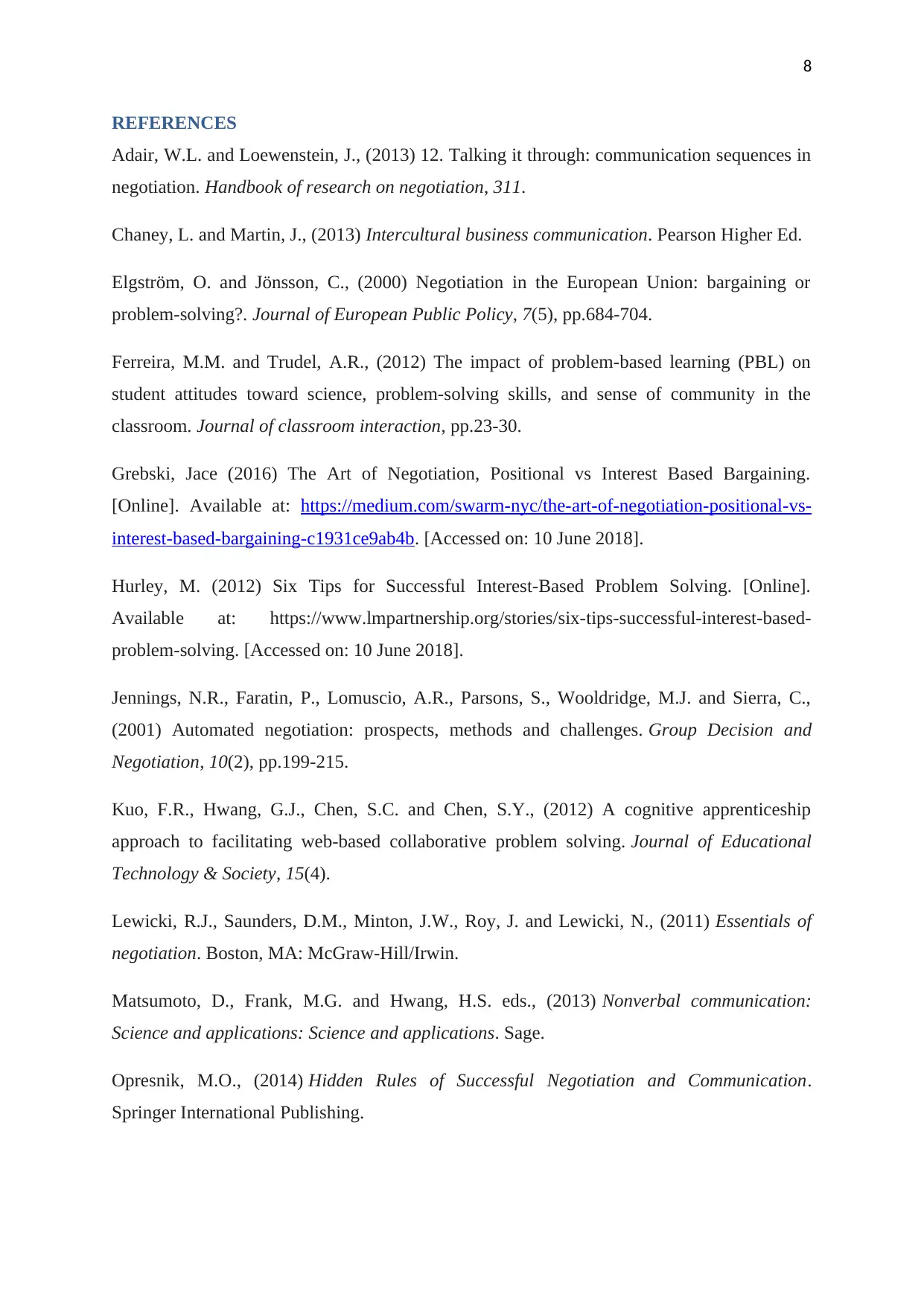
8
REFERENCES
Adair, W.L. and Loewenstein, J., (2013) 12. Talking it through: communication sequences in
negotiation. Handbook of research on negotiation, 311.
Chaney, L. and Martin, J., (2013) Intercultural business communication. Pearson Higher Ed.
Elgström, O. and Jönsson, C., (2000) Negotiation in the European Union: bargaining or
problem-solving?. Journal of European Public Policy, 7(5), pp.684-704.
Ferreira, M.M. and Trudel, A.R., (2012) The impact of problem-based learning (PBL) on
student attitudes toward science, problem-solving skills, and sense of community in the
classroom. Journal of classroom interaction, pp.23-30.
Grebski, Jace (2016) The Art of Negotiation, Positional vs Interest Based Bargaining.
[Online]. Available at: https://medium.com/swarm-nyc/the-art-of-negotiation-positional-vs-
interest-based-bargaining-c1931ce9ab4b. [Accessed on: 10 June 2018].
Hurley, M. (2012) Six Tips for Successful Interest-Based Problem Solving. [Online].
Available at: https://www.lmpartnership.org/stories/six-tips-successful-interest-based-
problem-solving. [Accessed on: 10 June 2018].
Jennings, N.R., Faratin, P., Lomuscio, A.R., Parsons, S., Wooldridge, M.J. and Sierra, C.,
(2001) Automated negotiation: prospects, methods and challenges. Group Decision and
Negotiation, 10(2), pp.199-215.
Kuo, F.R., Hwang, G.J., Chen, S.C. and Chen, S.Y., (2012) A cognitive apprenticeship
approach to facilitating web-based collaborative problem solving. Journal of Educational
Technology & Society, 15(4).
Lewicki, R.J., Saunders, D.M., Minton, J.W., Roy, J. and Lewicki, N., (2011) Essentials of
negotiation. Boston, MA: McGraw-Hill/Irwin.
Matsumoto, D., Frank, M.G. and Hwang, H.S. eds., (2013) Nonverbal communication:
Science and applications: Science and applications. Sage.
Opresnik, M.O., (2014) Hidden Rules of Successful Negotiation and Communication.
Springer International Publishing.
REFERENCES
Adair, W.L. and Loewenstein, J., (2013) 12. Talking it through: communication sequences in
negotiation. Handbook of research on negotiation, 311.
Chaney, L. and Martin, J., (2013) Intercultural business communication. Pearson Higher Ed.
Elgström, O. and Jönsson, C., (2000) Negotiation in the European Union: bargaining or
problem-solving?. Journal of European Public Policy, 7(5), pp.684-704.
Ferreira, M.M. and Trudel, A.R., (2012) The impact of problem-based learning (PBL) on
student attitudes toward science, problem-solving skills, and sense of community in the
classroom. Journal of classroom interaction, pp.23-30.
Grebski, Jace (2016) The Art of Negotiation, Positional vs Interest Based Bargaining.
[Online]. Available at: https://medium.com/swarm-nyc/the-art-of-negotiation-positional-vs-
interest-based-bargaining-c1931ce9ab4b. [Accessed on: 10 June 2018].
Hurley, M. (2012) Six Tips for Successful Interest-Based Problem Solving. [Online].
Available at: https://www.lmpartnership.org/stories/six-tips-successful-interest-based-
problem-solving. [Accessed on: 10 June 2018].
Jennings, N.R., Faratin, P., Lomuscio, A.R., Parsons, S., Wooldridge, M.J. and Sierra, C.,
(2001) Automated negotiation: prospects, methods and challenges. Group Decision and
Negotiation, 10(2), pp.199-215.
Kuo, F.R., Hwang, G.J., Chen, S.C. and Chen, S.Y., (2012) A cognitive apprenticeship
approach to facilitating web-based collaborative problem solving. Journal of Educational
Technology & Society, 15(4).
Lewicki, R.J., Saunders, D.M., Minton, J.W., Roy, J. and Lewicki, N., (2011) Essentials of
negotiation. Boston, MA: McGraw-Hill/Irwin.
Matsumoto, D., Frank, M.G. and Hwang, H.S. eds., (2013) Nonverbal communication:
Science and applications: Science and applications. Sage.
Opresnik, M.O., (2014) Hidden Rules of Successful Negotiation and Communication.
Springer International Publishing.
⊘ This is a preview!⊘
Do you want full access?
Subscribe today to unlock all pages.

Trusted by 1+ million students worldwide
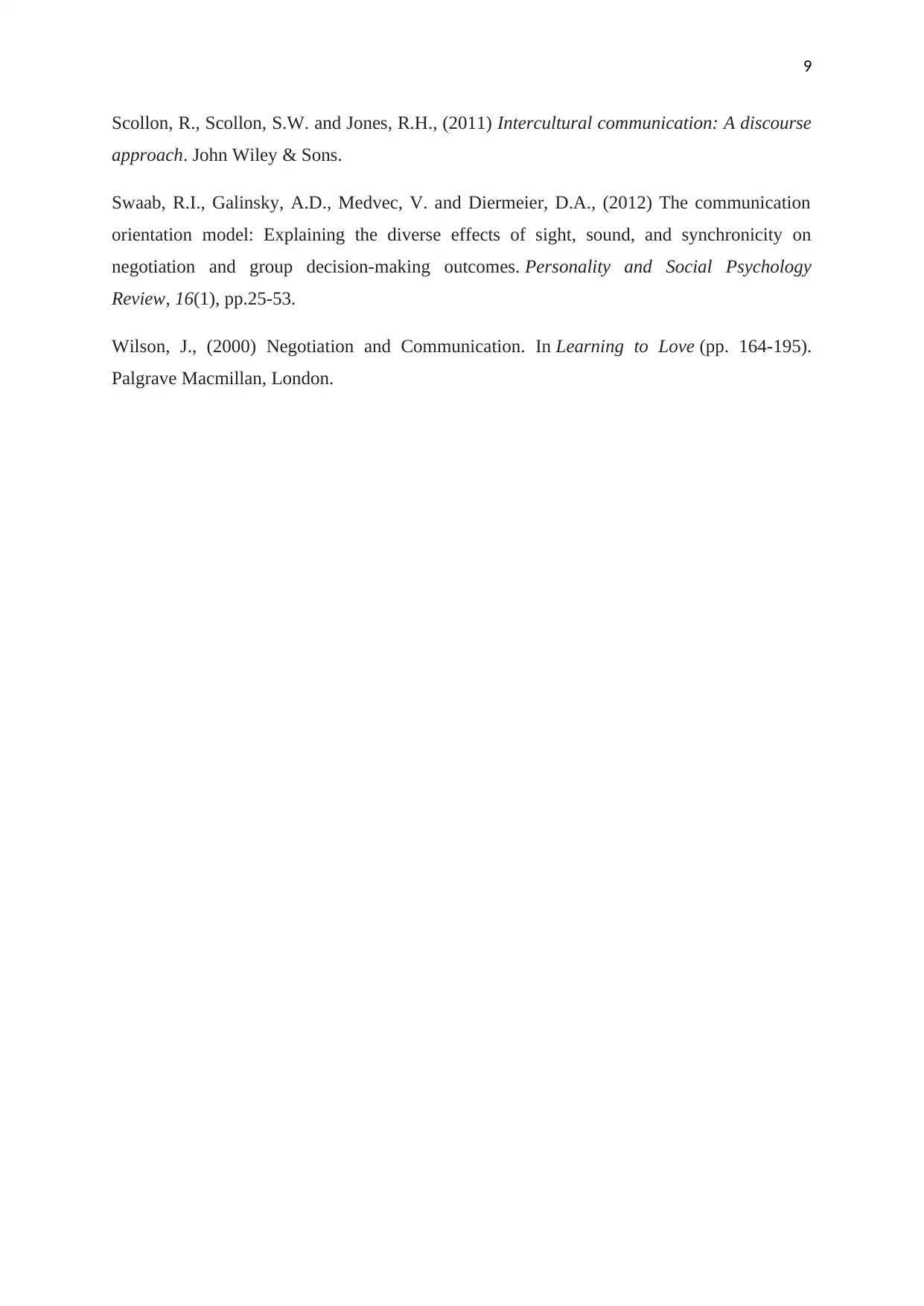
9
Scollon, R., Scollon, S.W. and Jones, R.H., (2011) Intercultural communication: A discourse
approach. John Wiley & Sons.
Swaab, R.I., Galinsky, A.D., Medvec, V. and Diermeier, D.A., (2012) The communication
orientation model: Explaining the diverse effects of sight, sound, and synchronicity on
negotiation and group decision-making outcomes. Personality and Social Psychology
Review, 16(1), pp.25-53.
Wilson, J., (2000) Negotiation and Communication. In Learning to Love (pp. 164-195).
Palgrave Macmillan, London.
Scollon, R., Scollon, S.W. and Jones, R.H., (2011) Intercultural communication: A discourse
approach. John Wiley & Sons.
Swaab, R.I., Galinsky, A.D., Medvec, V. and Diermeier, D.A., (2012) The communication
orientation model: Explaining the diverse effects of sight, sound, and synchronicity on
negotiation and group decision-making outcomes. Personality and Social Psychology
Review, 16(1), pp.25-53.
Wilson, J., (2000) Negotiation and Communication. In Learning to Love (pp. 164-195).
Palgrave Macmillan, London.
1 out of 10
Related Documents
Your All-in-One AI-Powered Toolkit for Academic Success.
+13062052269
info@desklib.com
Available 24*7 on WhatsApp / Email
![[object Object]](/_next/static/media/star-bottom.7253800d.svg)
Unlock your academic potential
Copyright © 2020–2025 A2Z Services. All Rights Reserved. Developed and managed by ZUCOL.




